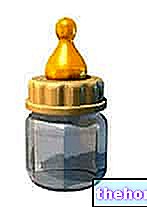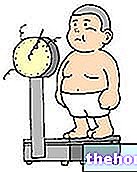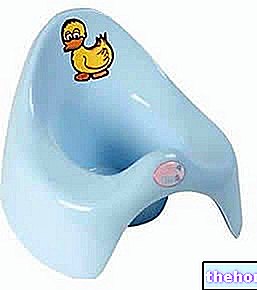Generality
Brachycephaly is a "cranial abnormality typical of infants, characterized by" posterior flattening of the cranial vault.
Generally, this flattening makes the head particularly wide, high and - if viewed from above - similar to a trapezoid.

Except in special cases, in order to positively resolve the anomalies of brachycephaly they do not need special medical treatments, but only simple precautions, such as: vary the position of the child when he is awake, put him to sleep on a slightly inclined shelf, etc.
Recalls of the anatomy of the human skull
Provided with bones and cartilages, the skull is the skeletal structure of the head that makes up the face and protects the brain, cerebellum, brainstem and sensory organs.
Contrary to what many people believe, its organization is very complex, perhaps among the most complicated in the human body. In fact, it has between 22 and 28 bones, which are even and uneven, have an irregular shape and are of the flat type (flat bones).
To simplify the study and understanding of the skull, anatomists thought of dividing it into two compartments, called neurocranium and splanchnocranium.
NEUROCRANIUM
The neurocranium is the upper cranial region, containing the brain and some of the main sensory organs. Its most important bones - strictly flat - are the frontal, temporal, parietal and occipital bones; these, together, form the so-called cranial vault. .
SPLANCNOCRANIUM
The splanchnocranium, or facial massif, is the antero-inferior region of the skull, made up of even and uneven bones. It represents the skeletal structure of the face, therefore it contains bone elements such as the mandible, the upper jaw, the cheekbones, the nasal bone, etc.

Figure: human skull.The main bones of the cranial vault and the neurocranium / splanchnocranium anatomical subdivision are shown (N.B: the red line ideally separates the neurocranium from the splanchnocranium).
DEVELOPMENT OF THE SKULL
At birth and during the first months of life, the cranial bones of newborns - especially those of the cranial vault - are easily modeled, as they are still soft, tender and not fused together.
As they grow, they merge in some strategic points (cranial sutures) and their consistency changes: they gradually become "stronger", less malleable and more resistant to shocks and constant pressure.
This process, which involves the progressive strengthening of the cranial bones, is part of the numerous mechanisms of ossification, affecting the human body.
What is brachycephaly?
Brachycephaly is a "morphological anomaly of the skull, typical of young children, characterized by a generalized flattening of the occipital (and therefore posterior) compartment of the cranial vault.
The flattening (or squashing) causes the head to appear developed in amplitude and much shorter than normal.
If it is not severe or with particularly serious causes, brachycephaly is a condition that usually heals without special medical treatment.

Figure: Starting from the left, the photos show a child with a normal head (normocephaly), a case of mild brachycephaly, a case of moderate brachycephaly and a case of severe brachycephaly. From the site: www.cranialtech.com
ORIGIN OF THE NAME
The word brachycephaly derives from the "union of two terms of Greek origin:" brachys "(βρᾰχῠίς‚), which means "short", and "chefale" (κεφαλή), which means "head".
Hence, the literal meaning of brachycephaly is "short head".
BRACHYCEPHALIA AND FLAT HEAD IN NEWBORN
Along with plagiocephaly, brachycephaly represents one of two causes of a more general condition known as flat head in the newborn or flat head syndrome.
WHY DO IT HIT SMALL CHILDREN?
Brachycephaly affects infants and very young children because the bones of the cranial vault are still soft and malleable (i.e., changeable).
Causes
Brachycephaly has several causes.
Currently, the most common is prolonged supine positioning of the baby, during the night and during daily naps. In fact, the supine position can involve the total support of the entire back region of the head on the bed or cradle, in which the child sleeps. All this causes an abnormal pressure, damaging the affected cranial region; pressure which, over time and due to the high malleability of the infant's cranial bones, can induce a change in the shape of the skull.
Brachycephaly resulting from the child's prolonged supine positioning is called postural brachycephaly.
Attention: Reading the above, some readers may consider it wrong to lay your baby on your back while sleeping. However, it should be noted that this is not the case at all: the supine position is correct and, unlike that on the side or on the stomach, it is not one of the factors favoring the so-called sudden infant death (SIDS).
OTHER POSSIBLE CAUSES
Other various causes of brachycephaly include:
- Some problems of the uterus and intrauterine life.
According to some researches, the insufficiency of amniotic fluid - a condition that takes the name of oligohydramnios - is responsible for morphological alterations of the head, including brachycephaly and plagiocephaly.
In particular, it would be decisive when the fetus, during labor, crosses the cervical canal of the uterus. - Premature birth.
In "crossing the cervical canal, children who are born prematurely have a greater tendency to undergo an alteration of the shape of the skull, as the malleability and softness of the cranial bones are even higher than in full-term births.
In this regard, readers are reminded that the last weeks of pregnancy are decisive for strengthening the cranial bones and making them resistant enough to avoid alterations during the crossing of the cervical canal. - Craniosynostosis.
Craniosynostosis is the term used by doctors to indicate a "skull anomaly, following the premature fusion of one or more cranial sutures.
The craniosynostosis responsible for brachycephaly is that which affects the coronal sutures, which lie between the frontal bone and the parietal bones.
As will be seen later, the craniosynostosis of the coronal sutures always requires surgery and this distinguishes brachycephaly due to the premature fusion of the aforementioned sutures from that due to one of the preceding causes.
EPIDEMIOLOGY
Brachycephaly is much more common today than in the past, due to a marked increase in cases of postural brachycephaly. It is widespread almost equally in all the various world ethnic groups and does not prefer a particular sex.
Symptoms and Complications
The clinical sign that characterizes every case of brachycephaly is the generalized flattening of the entire back of the head.
This typical manifestation usually involves:
- The presence of a head that is wider than normal. It is a characteristic that can be found by comparing a healthy individual with one suffering from brachycephaly.
- A head higher than normal. It can be added to the previous feature.
- The lack of the classic back curve of the head.
- The lack of proportionality between the face and the head. This is due to the head being developed in amplitude.
- Protruding ears.
- The trapezoidal shape of the head (N.B: if you look at the patient from above).
COMPLICATIONS
Generally, brachycephaly is only an aesthetic drawback, which, among other things, is usually temporary.
It is very rare that it causes complications: when it is responsible, these are often associated with craniosynostosis, a very uncommon condition that affects one in every 1,800 to 3,000 newborns.
Diagnosis
A physical examination is usually sufficient to diagnose brachycephaly and other accompanying abnormalities.
In medicine, an objective examination indicates the evaluation, by the doctor, of the symptoms and signs present and / or reported by the patient.
The use of more specific diagnostic tests - in this case instrumental tests such as X-rays or CT scans - occurs only in the presence of doubts regarding the causes; where there is suspicion of a craniosynostosis, the attending physician has the duty to investigate the situation thoroughly, to understand how to act from a therapeutic point of view.
Treatment
The treatment adopted varies according to the severity of the brachycephaly.
In case of slight flattening, the anomaly generally heals without particular care; in these cases it is sufficient to put into practice (by the parents) some simple precautions, the common purpose of which is to reduce the pressure on the back of the skull.
In the event of more marked crushing, the aforementioned measures are still useful, however they may not be enough to achieve healing. In fact, in these situations, it is probable that the remodeling of the head is only partial, therefore the morphological anomaly can leave signs of its passage.
Finally, the cases of brachycephaly sustained by craniosynostosis deserve a separate mention: these require specific medical treatment, the failure of which tends to have permanent repercussions.
SIMPLE REMEDIES TO REDUCE THE PRESSURE ON THE HEAD
The measures that allow to reduce the pressure on the back of the head are:
- When the baby is awake,
- Make him assume positions where he does not rest the back of his head on the shelf where he is. A valid solution is to lay him on his stomach (i.e. prone), taking care to always keep him awake and to stay in his company for as long as he remains in this position. These precautions are explained by the link, already mentioned, between the prone position during sleep and the sudden death of the infant.
- When the baby sleeps,
- Avoid always positioning it with the head straight, that is, in axis with the body. In other words, change its position often, so that there is no particular region of the head under greater pressure than others.
If this recommendation is difficult to implement, it is best to put the baby to sleep on a slightly inclined or flat shelf. - When the child plays,
- Often change the position of the toys that attract her attention the most. This can be a way to make him dizzy frequently when on his bed.
- When you are traveling with your baby or taking him for a walk,
- Provide for the use of seats and strollers that do not involve excessive pressure on the entire occipital region of the head.
Again, it is essential that the parent makes the child change the position of the head often.
A particularly valid remedy is to use baby wraps or backpacks, which allow the parent to hold the baby in front of him, without the latter resting his head on some shelf.
Before these measures begin to bear fruit, parents may have to wait 6 to 8 weeks.
IN THE PRESENCE OF CRANIOSYNOSTOSIS
Brachycephaly due to craniosynostosis requires a "surgical operation ad hoc, the purpose of which is to separate the cranial sutures fusing prematurely between them.
To know the various steps of the intervention, the reader can consult the article present here.
USE OF HELMETS: ARE THEY EFFECTIVE?
In some countries of the world, doctors use cranial orthoses, similar to helmets, with the aim of protecting the head from any pressure and favoring the correction of morphological abnormalities such as plagiocephaly or brachycephaly.
Especially in recent years, the use of these corrective tools has raised some doubts. Several experts, in fact, believe that cranial orthoses produce limited improvements, especially when compared with the aforementioned measures.
Furthermore, they advise against its use for two other reasons: they are expensive (and not all families could afford them) and very uncomfortable for the child.
Prognosis
With the appropriate measures, mild forms of brachycephaly heal completely between the first and second year of life.




























